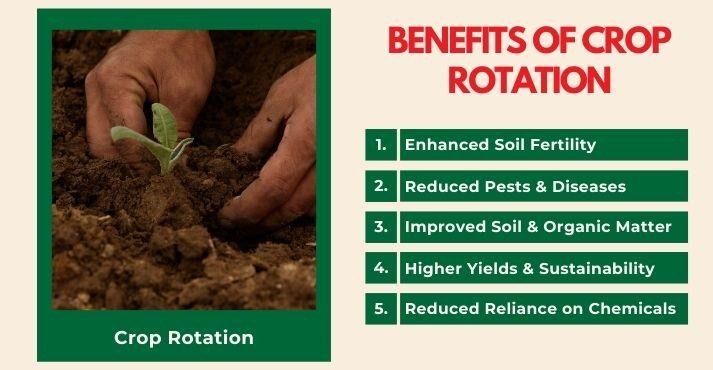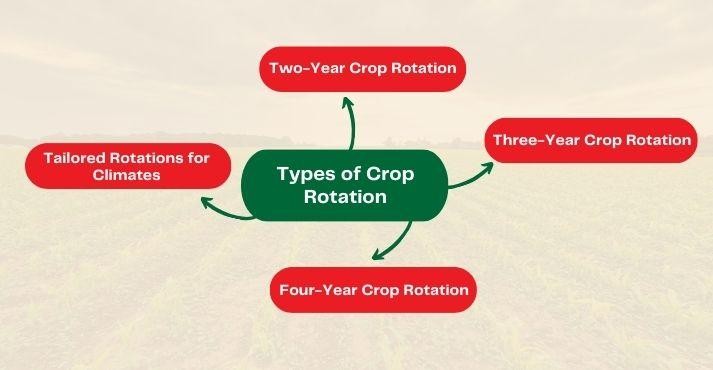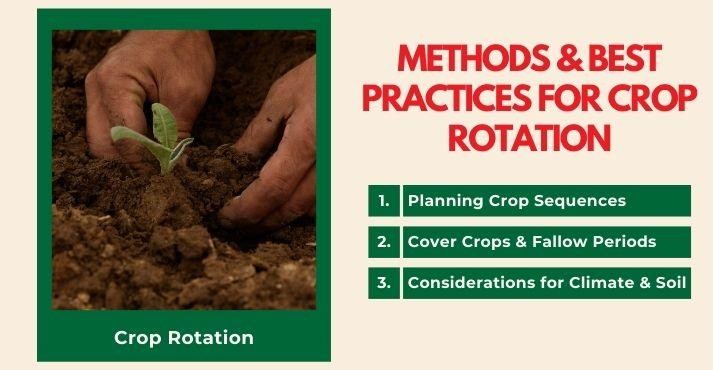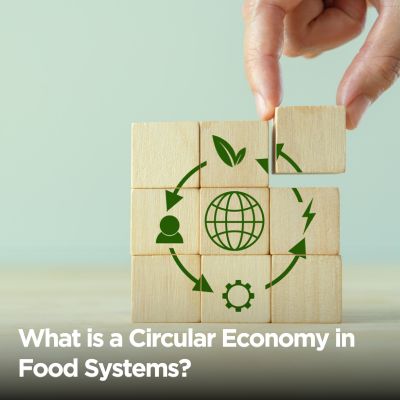Crop rotation is an agricultural practice in which different crops are planted on the same land in a planned sequence.
This method of growing crops helps improve soil health, reduce pest build-up, and maintain nutrient balance, ultimately leading to better yields. Farmers have relied on crop rotation for generations to preserve the fertility of their land.
In modern farming, crop rotation offers a sustainable way to optimize land use, boost productivity, and minimize the need for chemical inputs. In this blog, we’ll explore crop rotation and its many benefits for today’s farmers.
What is Crop Rotation?
Crop rotation is a sustainable farming technique in which different crops are grown on the same plot of land in a planned sequence.
For example, a farmer might plant nitrogen-fixing legumes like beans one season and then follow with nutrient-demanding farm crops such as wheat or corn.
This intentional switch helps restore soil nutrients, disrupt pest and disease cycles, and reduce the need for synthetic fertilizers and pesticides.
Additionally, crop rotation improves soil structure by diversifying root systems and encourages biodiversity in the farming ecosystem. Farmers can ensure healthier fields and contribute to more sustainable agricultural practices by adopting crop rotation.
Benefits of Crop Rotation

Crop rotation is much more than a traditional farming practice; it is an effective and sustainable way to boost agricultural productivity, enhance soil health, and protect the environment.
Let’s explore the crop rotation benefits for farmers, especially in regions like South Asia, where smallholder farmers depend heavily on the land for their livelihoods.
1. Enhanced Soil Fertility
One of the most significant advantages of crop rotation is its positive impact on soil fertility. By rotating different types of crops, farmers ensure that the soil doesn’t become overly depleted of specific nutrients.
For example, legumes like beans, peas, and lentils are especially beneficial because their roots host nitrogen-fixing bacteria. These bacteria convert atmospheric nitrogen into forms that plants can use, enriching the soil.
This process is important for organic food production, where minimizing the use of synthetic fertilizers is a priority.
Rotating legumes with nutrient-demanding crops such as wheat or rice creates a balanced cycle of nutrient replenishment. This practice reduces farmers’ dependency on synthetic nitrogen fertilizers, which can be costly and harmful to ecosystems.
Additionally, healthier soil leads to stronger plant growth and better yields, creating a sustainable loop of agricultural productivity.
In South Asia, particularly in countries like Bangladesh, incorporating legumes like lentils and chickpeas in the cropping cycle has improved soil health and increased crop yields.
2. Reduced Pests and Diseases
Crop rotation helps prevent pests and diseases from multiplying, which often happens when the same crop is grown repeatedly in one area. When crops are rotated, pests and pathogens specializing in one plant type struggle to establish themselves, breaking their lifecycle.
For example, in rice-growing regions of Southeast Asia, farmers often rotate rice with crops like maize, mustard, or vegetables. This rotation interrupts the life cycle of pests like the rice stem borer and diseases such as rice blast, as they lose access to their preferred host plants.
Crop rotation breaks these cycles and significantly reduces the need for chemical pesticides. This lowers production costs and reduces farming’s environmental impact. Moreover, using fewer pesticides ensures safer food for consumers and healthier farming communities.
3. Improved Soil Structure and Organic Matter
Crop rotation also enhances the structure of the soil and boosts its organic content. Different crops have different root systems that help improve soil quality by allowing air to circulate and boosting water retention.
Deep-rooted crops like maize or cotton break through compacted soil layers, enhancing aeration and water absorption. This helps nutrients distribute more evenly throughout the soil.
Shallow-rooted crops like legumes help protect soil from erosion, especially in regions with heavy rainfall where topsoil is at risk.
Additionally, crop residues from harvested plants decompose, enriching the soil with organic matter that boosts nutrient content and water retention.
This combination of root activity and organic decomposition eventually leads to healthier, more resilient soil supporting a diverse range of crops.
4. Higher Yields and Sustainability
Farmers who practice crop rotation often experience higher and more stable yields over time. By maintaining a healthy nutrient balance and managing pests more effectively, rotated fields produce more abundant crops than monoculture systems.
Crop rotation encourages the efficient use of natural resources, such as water and soil. It helps to maintain soil structure, which leads to better root growth and nutrient absorption.
Furthermore, this method promotes long-term sustainability by minimizing the need for chemical fertilizers and pesticides, reducing farming’s environmental impact. It supports higher productivity and helps preserve the land for future generations.
5. Reduced Reliance on Chemical Inputs
One of crop rotation’s most impactful benefits is its ability to minimize the need for synthetic fertilizers and pesticides, essential for growing natural food.
Healthy soil, enriched through natural processes like nitrogen fixation, requires fewer chemical additives to support plant growth. Similarly, breaking pest and disease cycles reduces the need for chemical pesticides.
Crop rotation offers a cost-effective solution for South Asian farmers, where the cost of agricultural inputs can be a significant burden. Smallholder farmers can maintain high productivity without over-relying on expensive and environmentally harmful chemicals.
This approach supports individual livelihoods and contributes to sustainable and eco-friendly agriculture efforts.
Types of Crop Rotation

Crop rotation provides flexible systems that farmers can adapt based on their specific needs and available resources. Depending on the region, crop preferences, and soil conditions, rotations can range from simple two-crop systems to more complex, multi-year rotations.
Below are some common systems of rotating crops that benefit soil health and agricultural productivity:
1. Two-Year Crop Rotation
One of the simplest systems is the two-year crop rotation. It typically involves alternating between cereals (such as wheat or maize) and legumes (like peas or beans).
Legumes are valuable because they help add nitrogen to the soil, enriching it for the following farm crops. This process, called “nitrogen fixation,” naturally enhances soil fertility, reducing the need for chemical fertilizers.
By alternating between nitrogen-demanding crops (like cereals) and nitrogen-fixing crops (like legumes), farmers can maintain soil fertility without relying heavily on synthetic fertilizers. This system is especially popular in regions with limited land, where farmers seek a balance of simplicity and effectiveness.
A typical two-year rotation might involve planting wheat in the first year and legumes like beans or peas in the second. This helps sustain soil health and reduces input costs related to fertilizers.
2. Three-Year Crop Rotation
A three-year crop rotation includes a broader range of crops and helps further improve soil health and pest management. This system typically incorporates three types of crops: a cereal (like wheat or maize), a legume (such as peas or beans), and a root crop (such as potatoes or carrots).
Each crop serves a specific purpose. Legumes fix nitrogen in the soil, cereals use these nutrients efficiently, and root crops help aerate the soil and enhance water infiltration. Together, these crops create a balanced ecosystem that supports long-term soil fertility.
Root crops are essential in this rotation system. Their deep roots penetrate compacted soil, breaking it up and allowing water and nutrients to reach deeper layers. This improves soil structure, reduces erosion, and ensures better growth conditions for subsequent crops.
In addition, this rotation helps manage pest and disease cycles, as pests and diseases that affect one type of crop may not be able to affect the others in the sequence.
The three-year crop rotation system also benefits farmers by allowing them to diversify crop types. This is useful in regions with varied market demands or environmental conditions.
3. Four-Year Crop Rotation
A more advanced system, the four-year system of rotating crops, is often called the “Norfolk rotation,” named after its use in England.
This system alternates between four different types of crops: two types of cereals (like wheat and barley), legumes (such as peas or beans), root crops (like potatoes or carrots), and a fallow or cover crop (such as clover or grass).
Including a fallow or cover crop is important because it helps the soil recover and build up nutrients during periods when no main crops are grown.
Cover crops can also prevent soil erosion, improve soil organic matter, and increase biodiversity in the field. This four-field rotation is best for larger farms or areas with a strong focus on sustainable practices, as it minimizes nutrient depletion, reduces pest pressure, and supports more diverse farm ecosystems.
4. Tailored Rotations for Specific Climates
Not all crop rotations are the same. Rotations may be specifically designed to suit the local environment in regions with unique climatic conditions.
For example, rice-based rotations are common in tropical regions, particularly Southeast Asia. In these areas, rice may be rotated with farm crops like mung beans or vegetables, which help reduce pest pressure while complementing the rice-growing season.
Wheat-legume rotations are common in arid climates, such as parts of Central Asia and the Middle East. These rotations allow farmers to optimize water use while maintaining soil health.
These rotations consider water availability, temperature extremes, and local pest issues, enabling farmers to grow crops that thrive in their environment without depleting the soil’s resources.
Depending on the region’s specific needs, each crop rotation system offers different advantages. By selecting the appropriate type of crop rotation, farmers can optimize yields, reduce reliance on chemical inputs, and enhance long-term sustainability.
Methods and Best Practices for Crop Rotation

Crop rotation is an effective strategy for maintaining soil health, controlling pests, and optimizing crop productivity. However, successful crop rotation requires careful planning and attention to various factors, such as crop families, soil health, and regional climate conditions.
Farmers can design efficient rotations that align with environmental and economic goals by using methods that prioritize sustainable farming practices. Below, we’ll explore some methods and best practices to enhance crop rotation efforts:
1. Planning Crop Sequences
Effective crop rotation begins with planning the right sequence of crops. Crops must be grouped based on their family and nutrient requirements. For example, legumes (such as peas and beans) fix nitrogen in the soil, while cereals (like wheat and maize) demand nitrogen.
Alternating crops with different nutrient needs helps maintain soil balance and prevents nutrient depletion.
Farmers should consider each crop’s growing requirements when designing a rotation plan, including soil nutrients, root depth, and pest susceptibility.
A simple, effective sequence might start with a nitrogen-fixing legume, followed by a cereal crop and a root crop, which helps aerate the soil. This step-by-step approach ensures that each crop contributes to soil health while optimizing productivity.
2. Cover Crops and Fallow Periods
Integrating cover crops into the rotation system can significantly benefit soil health. Cover crops such as clover or rye serve multiple purposes, including adding organic matter, fixing nitrogen, and preventing soil erosion.
These crops also provide ground cover during fallow periods, reducing the risk of erosion by wind and water, especially in regions prone to extreme weather conditions.
After a crop has been harvested, the soil can rest (a fallow period) to regenerate naturally. Cover crops can be planted during this time to keep the soil active.
This practice helps replenish the soil’s organic matter, improving its ability to retain moisture and nutrients. Farmers can rotate between fallow periods and cover crops to ensure the soil remains healthy throughout the year.
3. Considerations for Climate and Soil Type
When planning crop rotations, it’s crucial to adapt the plan to the local climate and soil conditions. In tropical regions like Southeast Asia, where wet and dry seasons alternate, farmers often choose crops that thrive under these varying conditions.
For example, rice can be grown during the wet season, while drought-resistant crops like maize or pulses can be planted during the dry months.
Soil type also significantly influences which crops to rotate. Clay soils, for instance, can benefit from deep-rooted crops that help break up compacted layers, while sandy soils may need farm crops that retain moisture and add organic matter.
Understanding the specific needs of the land ensures that crop rotation is both effective and sustainable.
By combining these methods, including planning crop sequences, incorporating cover crops, and tailoring rotations to regional conditions, farmers can improve the resilience and productivity of their land over time.
The Future of Crop Rotation
Crop rotation continues to be a crucial practice in farming, but its future is even brighter, especially as we face the challenges of climate change and resource scarcity.
As farmers seek more sustainable methods, crop rotation offers a way to balance productivity with environmental health.
By embracing new technologies, including advancements in agritech and supporting government initiatives, crop rotation is set to become an important practice in the future of farming.
Role in Sustainable Agriculture
Crop rotation is an essential practice for sustainable agriculture, helping to meet global environmental goals. It reduces farmers’ dependence on chemical fertilizers and pesticides, lowering production costs and significantly reducing harmful emissions from farming.
Crop rotation, by improving soil health and enhancing water management, supports the broader goal of reducing greenhouse gases.
As the demand for resilient agricultural systems grows, crop rotation remains essential for the future of food and sustainable agriculture, ensuring that productivity and environmental care go hand in hand.
By adopting these principles, farmers contribute to a thriving planet and secure the food supply for future generations.
Integration with Modern Technology
Modern technology is taking crop rotation to the next level. Precision farming tools, such as soil sensors, drones, and AI-based planning systems, give farmers real-time data on soil conditions, water usage, and nutrient levels.
These tools, essential components of the growing foodtech sector, allow farmers to optimize each crop cycle for maximum yield while minimizing environmental impact.
In addition, innovations such as genetically modified food create more resilient plant varieties capable of thriving in diverse conditions. This complements the data-driven approach by ensuring farmers have options for different environmental and market demands.
With these advancements, farmers have a high-tech roadmap to make smarter decisions and better manage their land, ensuring sustainable and productive agricultural practices.
Government and NGO Initiatives
Governments and NGOs increasingly recognize the value of crop rotation and are working hard to help farmers adopt these practices. Some programs in countries like Indonesia and Malaysia offer training, financial support, and resources to help farmers integrate crop rotation into their routines.
When local communities are empowered with the right tools and support, crop rotation becomes a simple concept and a practical, everyday solution. This allows farmers to thrive while protecting the environment, turning collaboration into tangible progress.
Conclusion
The purpose of crop rotation is to help farmers maintain healthy soils, manage pests, and improve overall farm productivity. It reduces dependency on chemical fertilizers and pesticides, offering an eco-friendly and cost-effective solution for sustainable farming.
As farming evolves, combining traditional practices like crop rotation with modern technologies and government support promises a more sustainable and efficient future for agriculture worldwide.
By adopting these methods, we can help ensure long-term food security and protect the environment.





























